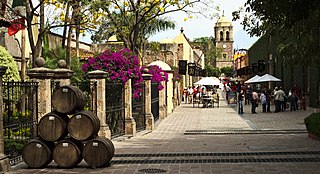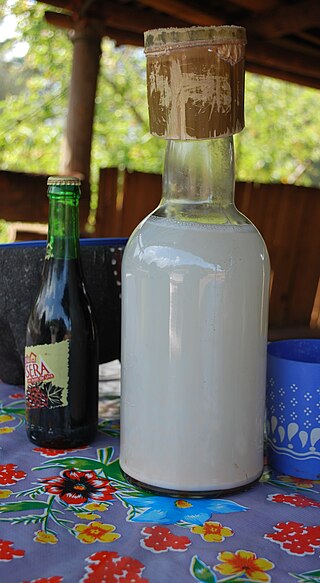
Tequila is a distilled beverage made from the blue agave plant, primarily in the area surrounding the city of Tequila 65 km (40 mi) northwest of Guadalajara, and in the Jaliscan Highlands of the central western Mexican state of Jalisco.

Mezcal, sometimes spelled mescal, is a distilled alcoholic beverage made from any type of agave. The word mezcal comes from Nahuatl mexcalli[meʃˈkalːi], which means "oven-cooked agave", from metl[met͡ɬ] and ixcalli[iʃˈkalːi]. Traditionally the word "mezcal" has been used generally in Mexico for all agave spirits and it continues to be used for many agave spirits whether these spirits have been legally certified as "mezcal" or not, and it is also considered a drink of artisan origin.

Agave americana, common names century plant, maguey, or American aloe, is a species of flowering plant in the family Asparagaceae, native to Mexico and the United States in Texas. It is cultivated worldwide as an ornamental plant, and has been naturalized in many regions, including parts of the West Indies, South America, Mediterranean Basin, Africa, Canary Islands, India, China, Thailand, and Australia.

Agave tequilana, commonly called blue agave or tequila agave, is an agave plant that is an important economic product of Jalisco, Mexico, due to its role as the base ingredient of tequila, a popular distilled beverage. The high production of sugars named agavins, mostly fructose, in the core of the plant is the main characteristic that makes it suitable for the preparation of alcoholic beverages.

Aguardente (Portuguese), or aguardiente (Spanish), is a generic term for alcoholic beverages that contain between 29% and 60% alcohol by volume (ABV). It originates in the Iberian Peninsula and in Iberian America.

Santiago de Tequila is a Mexican town and municipality located in the state of Jalisco about 60 km from the city of Guadalajara. Tequila is best known as being the birthplace of the drink that bears its name, “tequila,” which is made from the blue agave plant, native to this area. The heart of the plant contains sugars and had been used by native peoples here to make a fermented drink. After the Spanish arrived, they took this fermented beverage and distilled it, producing the tequila known today. The popularity of the drink and the history behind it has made the town and the area surrounding it a World Heritage Site. It was also named a "Pueblo Mágico" in 2003 by the Mexican federal government.

Sotol is a distilled spirit from the Chihuahuan desert sourced from the family of Asparagaceae; the genus Dasylirion and several species, most commonly: Dasylirion wheeleri, Dasylirion durangense, Dasylirion cedrosanum, and Dasylirion leiophyllum, less commonly with Dasylirion texanum and Dasylirion lucidum, a plant that grows in the Chihuahua desert of northern Mexico, New Mexico, Arizona, and west and central Texas. Sotol liquor is a Mexican drink that is known as the state spirit of Chihuahua, Durango and Coahuila. Sotol has its own appellation of origin since 2002, and may be produced only in Chihuahua, Coahuila and Durango. There are dozens of commercial examples available. Production of sotol spirits exists outside the Sotol Denomination of Origin in several regions such as Sonora where it is known as Palmilla, Oaxaca (Cucharillo), and the Texas Hill Country.
Jose Cuervo is the best-selling brand of tequila, selling a fifth of the tequila consumed worldwide.

Agave syrup, also known as maguey syrup or agave nectar, is a sweetener commercially produced from several species of agave, including Agave tequilana and Agave salmiana. Blue-agave syrup contains 56% fructose as a sugar providing sweetening properties.

El Espolón is a brand of tequila from Campari America. The tequila is produced by the Casa San Nicolas brand in the Los Altos (Highlands) region of Jalisco, Mexico. It has three products which are Blanco, Reposado and Añejo tequila. Each one is 80 proof or 40% ABV.

An alcoholic beverage is a drink that contains ethanol, a type of alcohol that acts as a drug and is produced by fermentation of grains, fruits, or other sources of sugar. The consumption of alcoholic drinks, often referred to as "drinking", plays an important social role in many cultures. Most countries have laws regulating the production, sale, and consumption of alcoholic beverages. Regulations may require the labeling of the percentage alcohol content and the use of a warning label. Some countries ban such activities entirely, but alcoholic drinks are legal in most parts of the world. The global alcoholic drink industry exceeded $1 trillion in 2018.

Pulque, or octli, is an alcoholic beverage made from the fermented sap of the maguey (agave) plant. It is traditional in central Mexico, where it has been produced for millennia. It has the color of milk, a rather viscous consistency and a sour yeast-like taste.

Agave is a genus of monocots native to the hot and arid regions of the Americas and the Caribbean, although some Agave species are also native to tropical areas of North America, such as Mexico. The genus is primarily known for its succulent and xerophytic species that typically form large rosettes of strong, fleshy leaves. Agave now includes species formerly placed in a number of other genera, such as Manfreda, ×Mangave, Polianthes and Prochnyanthes.

Sauza Tequila Import Company is a producer of tequila located in Tequila, a municipality of the state of Jalisco, Mexico. It was founded in 1873 when Don Cenobio Sauza started La Perseverancia distillery. Sauza Tequila Import Company is owned by Beam Suntory, headquartered in Chicago, Illinois. Their products include Sauza, Conmemorativo, Hornitos and Tres Generaciones.

Casa Dragones is a small batch tequila brand from San Miguel de Allende, Mexico. It was founded in 2009 by Bertha González Nieves, the first woman to be certified as ‘Maestra Tequilera’ by the Academia Mexicana de Catadores de Tequila, the organization recognized by The Tequila Regulatory Council, and MTV creator and iHeartMedia (iHeartradio) CEO Robert W. Pittman.

Tres Agaves is a brand of organic 100% de Agave Tequila and Margarita mixes. The Tequila is produced at Tres Agaves' distillery in the town of Amatitán located in Jalisco, Mexico.

Tequila Herradura is a tequila distiller located in Amatitán, Jalisco, Mexico. It was formally founded in 1870 by Aurelio López and the business remained in the family for over 125 years. Today it is owned by US beverage maker Brown-Forman, but the tequila is still made in the same place and facilities under a Mexican subsidiary. Tequila products sold under the Herradura name are 100% agave. The company makes other tequila products, such as El Jimador, which is the best-selling tequila in Mexico, as well as New Mix, a tequila and grapefruit soda beverage. Since its acquisition by Brown-Forman, Herradura has had many promotional efforts in Mexico and the United States, including inviting artists to use tequila barrels as the bases for art pieces, which are then displayed and auctioned off for charity.
Miske is an Ecuadorean distilled alcoholic beverage made from the sap of agave plants.














